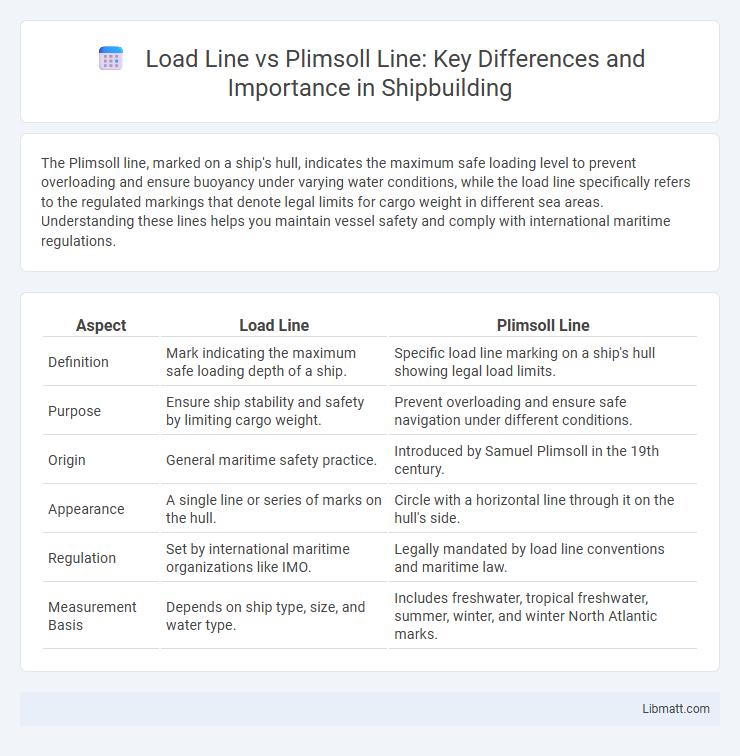The Plimsoll line, marked on a ship's hull, indicates the maximum safe loading level to prevent overloading and ensure buoyancy under varying water conditions, while the load line specifically refers to the regulated markings that denote legal limits for cargo weight in different sea areas. Understanding these lines helps you maintain vessel safety and comply with international maritime regulations.
Table of Comparison
| Aspect | Load Line | Plimsoll Line |
|---|---|---|
| Definition | Mark indicating the maximum safe loading depth of a ship. | Specific load line marking on a ship's hull showing legal load limits. |
| Purpose | Ensure ship stability and safety by limiting cargo weight. | Prevent overloading and ensure safe navigation under different conditions. |
| Origin | General maritime safety practice. | Introduced by Samuel Plimsoll in the 19th century. |
| Appearance | A single line or series of marks on the hull. | Circle with a horizontal line through it on the hull's side. |
| Regulation | Set by international maritime organizations like IMO. | Legally mandated by load line conventions and maritime law. |
| Measurement Basis | Depends on ship type, size, and water type. | Includes freshwater, tropical freshwater, summer, winter, and winter North Atlantic marks. |
Introduction to Load Line and Plimsoll Line
The Load Line is a marking on a ship's hull indicating the maximum safe draft under varying water conditions to prevent overloading, ensuring seaworthiness and stability. The Plimsoll Line, a specific type of Load Line, was introduced internationally to standardize these markings, providing a clear safety reference for shipmasters based on water salinity and seasonal variations. Understanding these critical lines helps you maintain vessel safety by accurately gauging loading limits in compliance with maritime regulations.
Historical Background of Ship Safety Marks
The Plimsoll line, introduced by Samuel Plimsoll in the 19th century, revolutionized ship safety by indicating maximum safe loading levels to prevent overloading and improve maritime safety. The load line has its origins in these early regulations but has evolved to include multiple marks reflecting different water types and seasonal conditions, addressing varying buoyancy and stability concerns across global waters. Your understanding of these historical safety marks is essential for recognizing modern regulations designed to protect vessels from dangerous overloading.
Defining the Load Line
The load line, also known as the Plimsoll line, is a crucial maritime marking on a ship's hull that indicates the maximum safe draft and legal limit to which a vessel can be loaded. It ensures the ship has sufficient freeboard and stability by accounting for factors such as water type, season, and temperature. Your vessel's load line prevents overloading, enhancing safety and compliance with international maritime regulations.
Understanding the Plimsoll Line
The Plimsoll line, also known as the load line, is a crucial maritime safety marking on a ship's hull that indicates the maximum safe loading level under various sea and weather conditions. This line ensures the vessel has sufficient freeboard to prevent overloading, reducing the risk of capsizing or sinking. International maritime regulations enforce strict adherence to the Plimsoll line to maintain vessel stability and prevent maritime accidents.
Key Differences: Load Line vs Plimsoll Line
The Load Line is a regulatory marking on a ship's hull indicating the maximum safe draft, ensuring vessel stability and safety under varying sea conditions. The Plimsoll Line, named after Samuel Plimsoll, is a specific type of load line that marks the legal limit to which a ship may be loaded to prevent overloading and ensure compliance with international maritime safety standards. Understanding the distinction between your vessel's Load Line and Plimsoll Line is crucial for maintaining proper load limits and avoiding penalties.
The Purpose and Importance of Each Line
The Load line, also known as the Plimsoll line, indicates the maximum safe draft, and therefore the maximum legal loading capacity of a vessel, ensuring it remains seaworthy under various conditions. Plimsoll lines are crucial for preventing overloading that can compromise stability and safety in rough seas. Understanding these lines helps you maintain proper vessel loading, reducing the risk of maritime accidents and regulatory penalties.
Regulatory Standards and International Conventions
The Load Line and Plimsoll line are critical regulatory marks mandated by the International Convention on Load Lines (ICLL) to ensure vessel safety and prevent overloading. The Plimsoll line specifically indicates the maximum safe draft, accounting for variations in water density and seasonal conditions, aligning with SOLAS (Safety of Life at Sea) standards. International maritime authorities enforce these marks to comply with global safety conventions, reducing the risk of maritime accidents due to improper loading.
Factors Influencing Load and Plimsoll Lines
Load lines and Plimsoll lines are influenced by factors such as water salinity, temperature, and seasonal weather conditions, which affect a ship's buoyancy and stability. Regulatory requirements and ship design also play critical roles in determining these lines, ensuring safety and compliance with maritime laws under varying sea conditions. Variations in cargo weight and distribution further impact the positioning of load and Plimsoll lines to maintain optimum vessel performance and prevent overloading.
Impact on Ship Design and Operations
The Load line and Plimsoll line are critical markers affecting ship design by determining safe loading limits to prevent overloading and ensure stability under varying water conditions. These markings influence operational decisions, including cargo distribution and voyage planning, to maintain compliance with international safety regulations. Understanding your vessel's load line ensures optimal performance and reduces risks related to structural stress and maritime hazards.
Conclusion: Ensuring Maritime Safety
The Load line and Plimsoll line are critical indicators that ensure the safe loading and buoyancy of ships, directly preventing overloading and risks of capsizing. By adhering to these maritime safety standards, you protect your vessel, cargo, and crew from dangerous sea conditions and regulatory violations. Understanding and respecting these markings is essential for maintaining operational safety and complying with international maritime laws.
Load line vs Plimsoll line Infographic

 libmatt.com
libmatt.com